Homeland of roses Italy. There in winter the temperature does not drop below +3 ° C. Russian florists have to prepare flowers for wintering, to shelter them from frost. On sale there are ready-made shelters in the form of winter houses for roses, removable covers, stakes for shelters, industrial covering materials. To preserve flower collections, use the products of industrial enterprises and improvised materials.
Content
Rose and winter hardiness
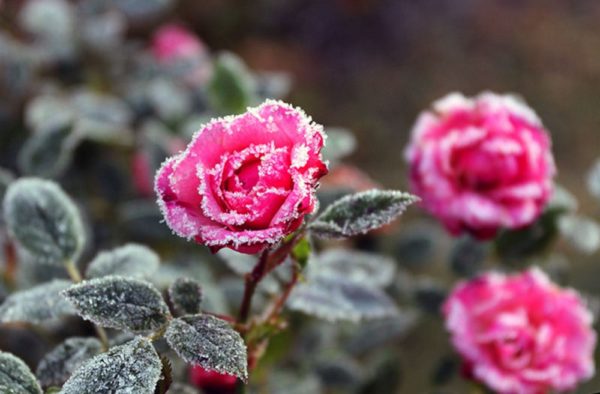 Winter hardiness of roses depends on the species. Some species in the middle lane can not be covered for the winter. In the Moscow region and other regions of the Central zone, modern hybrid forms of Rugosa rose winter without problems.
Winter hardiness of roses depends on the species. Some species in the middle lane can not be covered for the winter. In the Moscow region and other regions of the Central zone, modern hybrid forms of Rugosa rose winter without problems.
High frost resistance is distinguished by Canadian park roses:
- Adelaide Hoodless;
- Prairi Joy;
- Winnipeg Parks
- Hope of Humanity.
Gardeners are popular climbing roses. Some varieties tolerate frosts to -30 ° C (Alchemist, Handel), others freeze when the thermometer drops to -7 ° C. Climbing roses of continuous flowering require good shelter for the winter:
- Lagoon;
- Parade;
- Paul Scarlet.
Most hybrid tea varieties cannot withstand frosty winters; they are easier to grow in the southern regions. They require mandatory shelter if in winter the temperature drops to -20 ° C. Roses floribunda are frost-resistant, but in Siberia and the Urals they are sheltered for the winter.
When buying a seedling, it is necessary to specify the frost resistance zone (USDA). There are 13 of them and for each there is its own value for the minimum temperature. It is given without shelter. In the presence of a covering layer, roses can withstand frosts 5-10 ° lower than indicated in the recommendation.
Choosing a covering material
Bushes in winter suffer not only from low temperatures. Many inexperienced gardeners, because of improper shelter, they vypryvayut. In the middle lane temperature fluctuations are not uncommon. There is an infection of plants using natural materials. When deciding how to cover their roses for the winter, consider:
- frost resistance varieties;
- weather conditions;
- material properties (purchased, natural).
Purchased
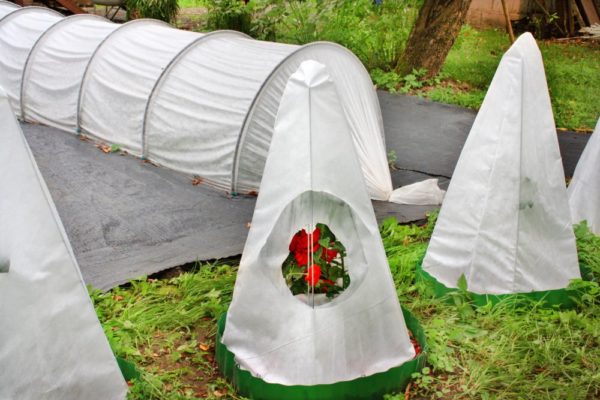 Covering materials for roses for the winter, made industrially, have a different composition, price, quality. Agrotextiles are sold in rolls or pieces of a specific format. Covering properties determine the density, it is measured in g / m². The greater the value, the more reliable the protection.
Covering materials for roses for the winter, made industrially, have a different composition, price, quality. Agrotextiles are sold in rolls or pieces of a specific format. Covering properties determine the density, it is measured in g / m². The greater the value, the more reliable the protection.
Lutrasil
Lightweight durable material for long-term use. You can use several seasons. Benefits of Lutrasil:
- passes air;
- there is no greenhouse effect under it;
- the canvas does not get wet.
To protect the flower garden from frost, lutrasil of white color, with a density of 60 g / m², is best suited. Roses are covered with material folded in 2 layers.
To cover the bushes, you can use a less dense material (30-50 g / m²). It is rolled up in 3-4 layers. There is a running meter of lutrasil from 25 to 50 rubles. On erect, thick shoots of covering material with their own hands sew covers. Flexible varieties of roses bend to the ground, leaving a gap to the ground (10-20 cm), set arcs, and sprinkle a non-woven fabric. On the sides it is fixed with studs, bricks, boards.
Geotextile
Geotextiles have long been used in industrial rosaries in the Moscow region.The canvas is sewn from 3 layers, cover them with large areas. All varieties of roses under it winter well without hilling. Group plantings are covered in one piece. For standard and climbing roses, they sew covers.
The canvas is laid on arcs or props, this allows you to distribute the snow load. From the bushes remove leaves and bend. The soil is covered with mulch from a mixture of dry sawdust and horse manure.
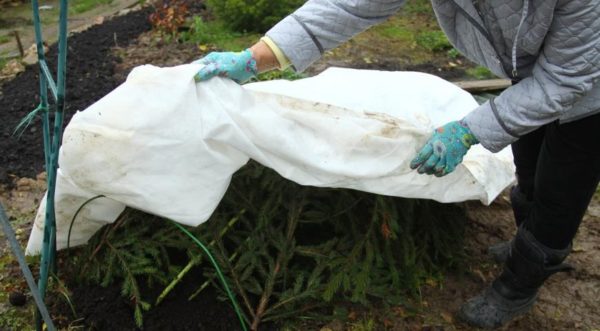 Geotextiles are used in construction and landscape design. It consists of polymer fibers. Sell it with rolls of different widths. In stores for gardeners, you can buy ready-made covers made of geotextiles. Material advantages:
Geotextiles are used in construction and landscape design. It consists of polymer fibers. Sell it with rolls of different widths. In stores for gardeners, you can buy ready-made covers made of geotextiles. Material advantages:
- strength;
- durability;
- frost resistance;
- environmental friendliness;
- air permeability;
- lack of condensate.
Polyethylene film
Attitude to the film as a means of protection against frost in gardeners is ambiguous. There are negative reviews, but many have successfully used it. In regions with harsh winters and thick snow cover, roses winter well under a shelter made of plastic film. An air cushion underneath protects the roots and shoots of roses from freezing.
Spanbond
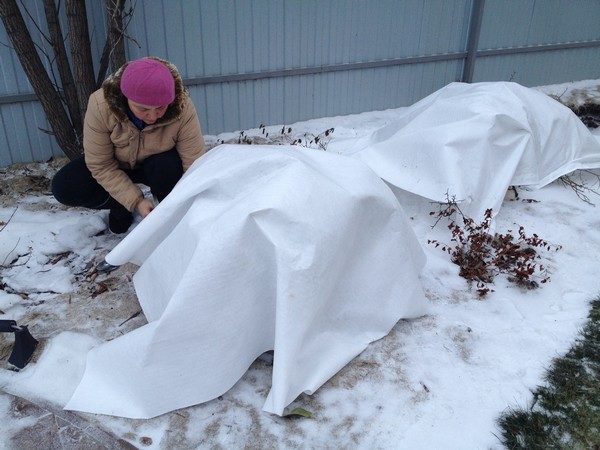 This material can be used for several seasons. He lets water, air. The cost of a spunbond is not high, this makes it affordable. Use it for winding single bushes of the standard type, pull on frames from plastic (metal) arcs, bars, willow rods.
This material can be used for several seasons. He lets water, air. The cost of a spunbond is not high, this makes it affordable. Use it for winding single bushes of the standard type, pull on frames from plastic (metal) arcs, bars, willow rods.
Spanbond is used in 2-3 layers, only white in density:
- 30 g / m²;
- 40 g / m²;
- 60 g / m².
Sackcloth
Jute bags or polypropylene from sugar is a budget option for shelters of roses for the winter. They are dressed in separately growing bushes. Dry leaves are poured inside, the bottom is fixed with twine and spud with earth. Vegetable nets are filled with dry fallen leaves, used as a heater.
Construction Materials
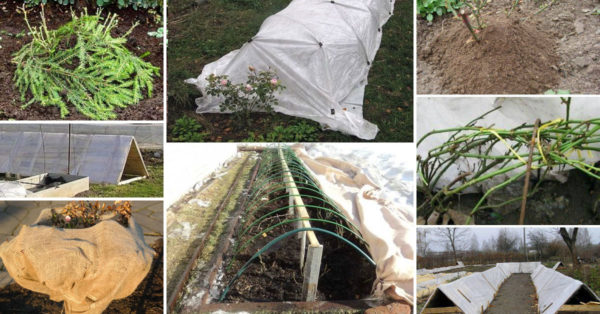
The materials remaining after the construction of cottages, a country house, may come in handy. Boards, bars go to the construction of shields, houses. The roofing material is laid on the ground before putting shoots on it. From slate sheets they build huts for roses. Expanded clay mulch with expanded clay.
Tools at hand
To fix the covering material, various improvised materials are used:
- ropes;
- twine;
- wooden or reinforced pegs;
- welding electrodes instead of staples;
- pieces of wire;
- boards;
- bricks.
Fir spruce
Lapnik is not accessible to everyone. It is used by those who live near coniferous forests. It is not suitable for sheltering large rose gardens, it needs a lot. To protect the undersized rose bushes from frost, you need to create a layer of branches at least 30 cm thick.
Shelter from spruce branches must be thrown with snow, pull covering material over it if there is no snow. You can close roses with spruce branches when the daytime temperature drops to -6 ° C.
Leaves
In the autumn in any garden there are enough leaves. They can be used to protect against frost if the trees are healthy. You can fill in rose bushes only with dry material. Wet leaves provoke the development of fungal diseases in roses.
Leaves without additional shelter will fly apart. To fix them around the bush, cardboard boxes, nets, small-mesh plastic mesh, wooden shields, and other materials at hand are used.
Sawdust
 Sawdust is best used by combining them with other types of shelters (shields, covering material). They are more suitable for regions with harsh winters, where thaws are a rarity. Not all sawdust is suitable for sheltering a flower garden.Can not use:
Sawdust is best used by combining them with other types of shelters (shields, covering material). They are more suitable for regions with harsh winters, where thaws are a rarity. Not all sawdust is suitable for sheltering a flower garden.Can not use:
- fine fraction;
- furniture waste containing chemicals.
As a covering material, it is better to use sawdust of coniferous species with a size of 10 mm or more. They are less caked, hygroscopic, have antiseptic properties. Warm with sawdust in different ways:
- they cover the near-trunk circle, put shields over the bushes, cover them with foil;
- do not tightly fill the nets with sawdust, lay them under the whips, put arcs on top, throw covering material;
- in the northern regions, shields are placed over a small bushes by a house, on top of them they are littered with a thick layer of sawdust.
Humus
This organic material does not protect the aerial part of the flower from frost. It is used to mulch the soil, it protects it from freezing, increases fertility. Humus is mixed with dry sawdust to make it more loose.
Three best designs for sheltering roses
You can’t save roses with frost cover materials alone. They are protected from low temperatures by an air cushion, which is created with the help of a rigid structure and covering material.
Wireframe method
The frame method is suitable for rose gardens, in which rose bushes grow at a great distance from each other. Covering them with a continuous cloth is expensive and hard. Around each plant stick sticks (3-5 pieces). From above they are fixed with wire.
It turns out a pyramid. It is wrapped in several layers of lutrasil or another non-woven covering material is used instead. The structure below to the ground is fixed with brackets, and above - with twine.
Over large flowerbeds of roses, another type of structure is being constructed. Use arcs, wooden shields. The resulting dome (house) is covered with covering material (film, lutrasil). While it is not very cold outside, the ends of the frame tunnel are kept open, and they are closed when frost sets in.
The arcs are stuck into the ground, the lower part of the shields is fixed with pegs, the covering material is pinned to the ground with brackets of wire, electrodes or pressed with boards, bricks. During thaws, the tunnels (pyramids) are aired to prevent the roots from siding.
Bulk fence
Option for single-planted bushes. Fences are built around their perimeter, which are filled with dry backfill:
- leaves;
- hay;
- thatch.
For the construction of the fence use stakes (rods) and a mesh (plastic, metal) or trim thin plywood, cardboard boxes.
Lutrasil Cocoon
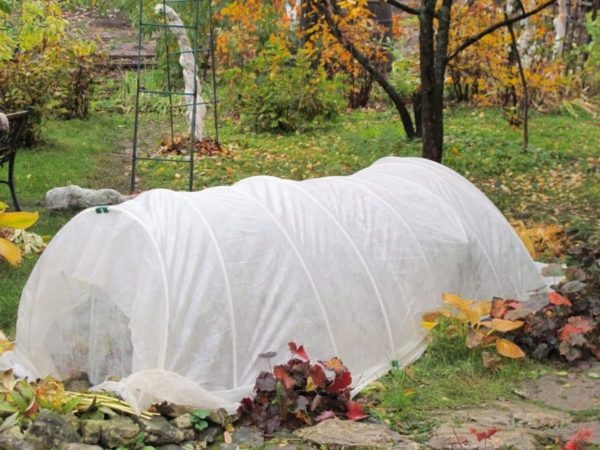 The method is suitable for protection against frost of single-growing standard and tall rose varieties. To build a cocoon, you need a piece of lutrasil and a rope (twine). Scourges are not removed from the support. The whole bush is wrapped in a non-woven fabric in several layers, fixed with a rope below.
The method is suitable for protection against frost of single-growing standard and tall rose varieties. To build a cocoon, you need a piece of lutrasil and a rope (twine). Scourges are not removed from the support. The whole bush is wrapped in a non-woven fabric in several layers, fixed with a rope below.
The roots are also insulated:
- spud;
- mulch.
Reviews
Alexey, 32 years old, Moscow region
In our area, not a single winter is complete without thaws. I tried harbor roses spruce litter (branches, needles), the result was deplorable. Shoots often roared out. Now I use arcs and non-woven covering material.
Svetlana, 43 years old, Moscow Region
She refused the film. Too much fuss with her. In spring, you need to open it in time so that the roses do not die. I cover with lutrasil. It can be removed in May, there will be nothing with bushes. From hilling, too, refused. My site is moist, the soil is loamy. The shoots blackened, cracks appeared on them.
Tamara, 60 years old, Kaluga
I fill the bushes with oak leaves, put crosswise arcs over them, pull the film. During the thaw, I open it a bit. Losses happen, because sometimes I do not have time to open it on time. I plan to switch to spanbond.
Finally
Lovers of roses note that all varieties of roses bloom earlier, more abundantly, longer if shelter for the winter. Plants are less likely to suffer from a fungal infection, because winter shelter serves as the prevention of rot, late blight, and other diseases.

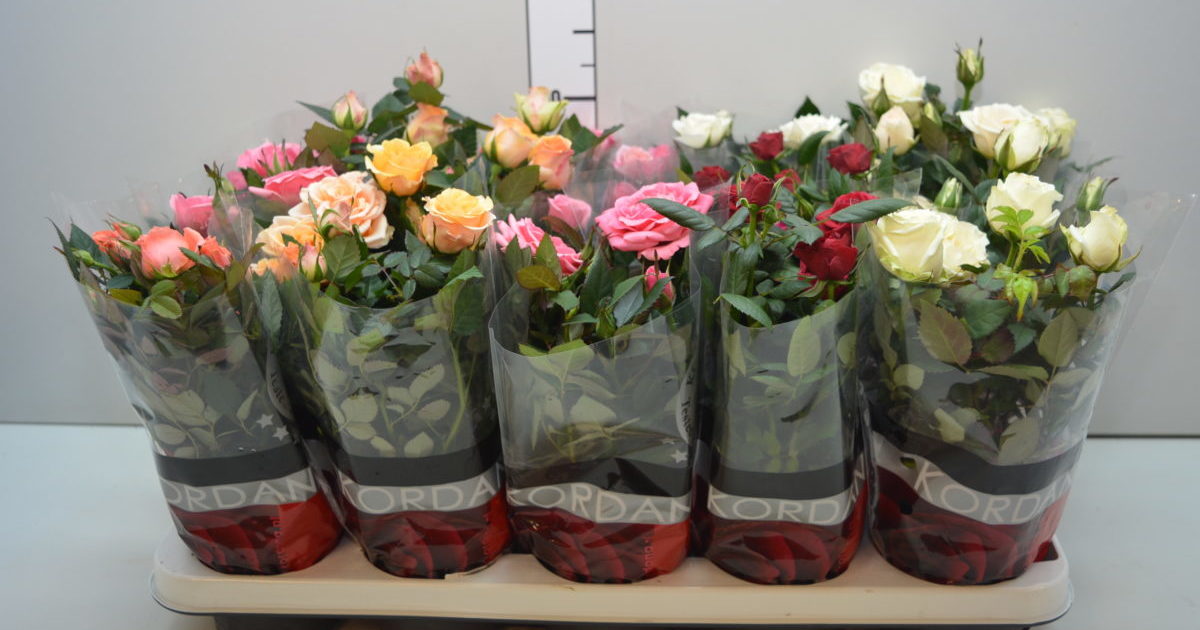
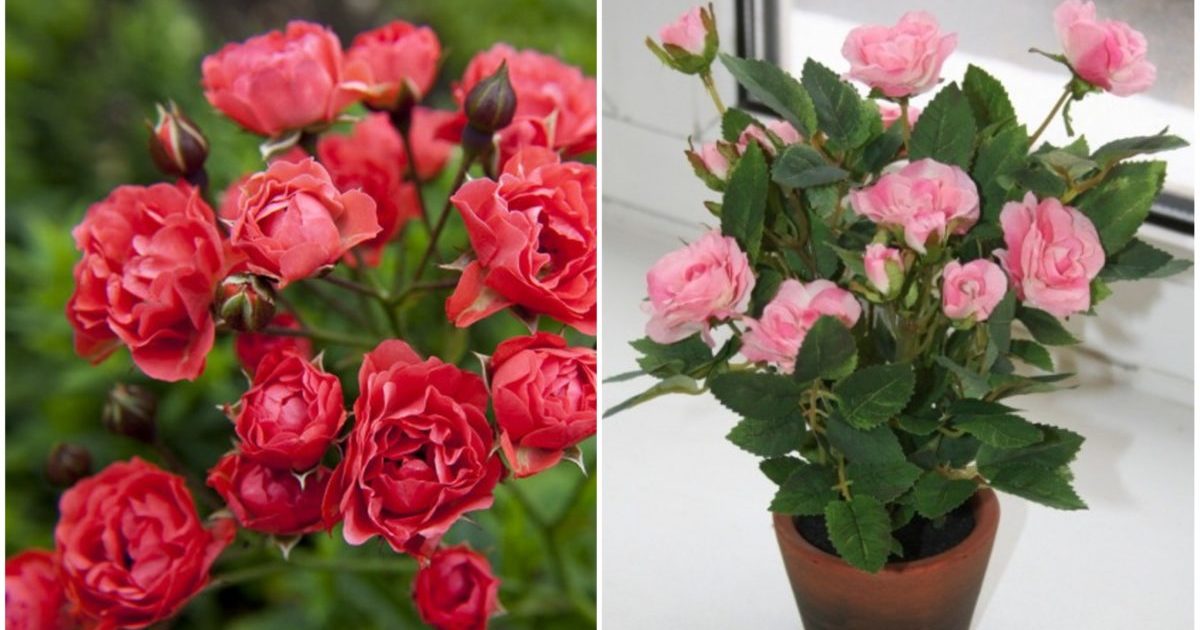
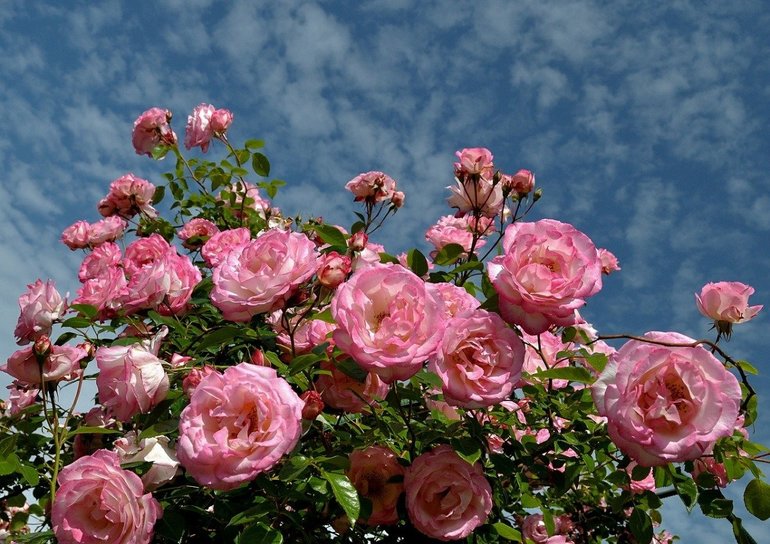
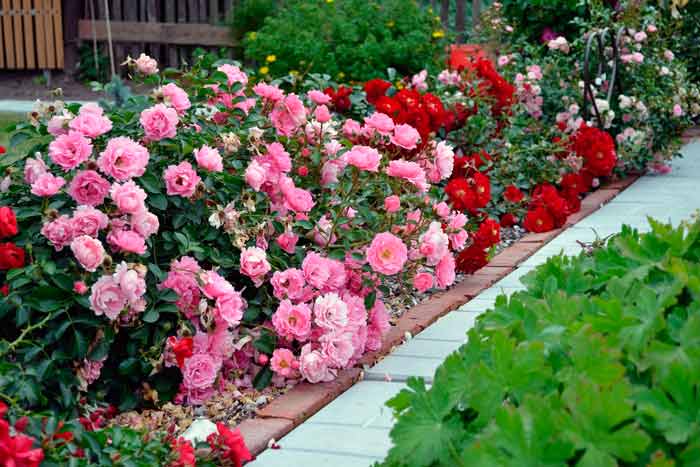 Shelter of roses for the winter: at what temperature does the robot hold
Shelter of roses for the winter: at what temperature does the robot hold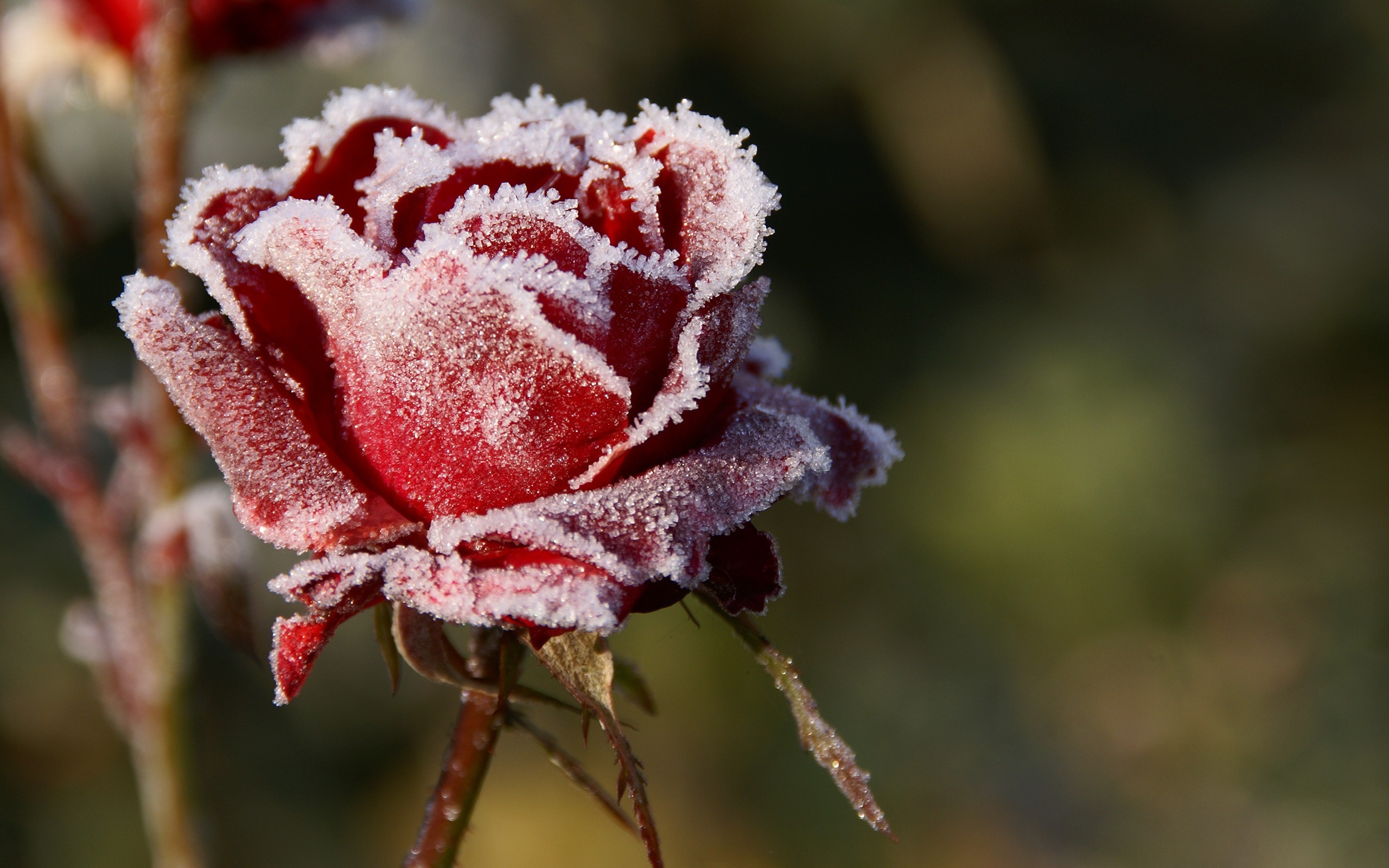 How to prune roses in the fall: timing, pruning rules, pros and cons
How to prune roses in the fall: timing, pruning rules, pros and cons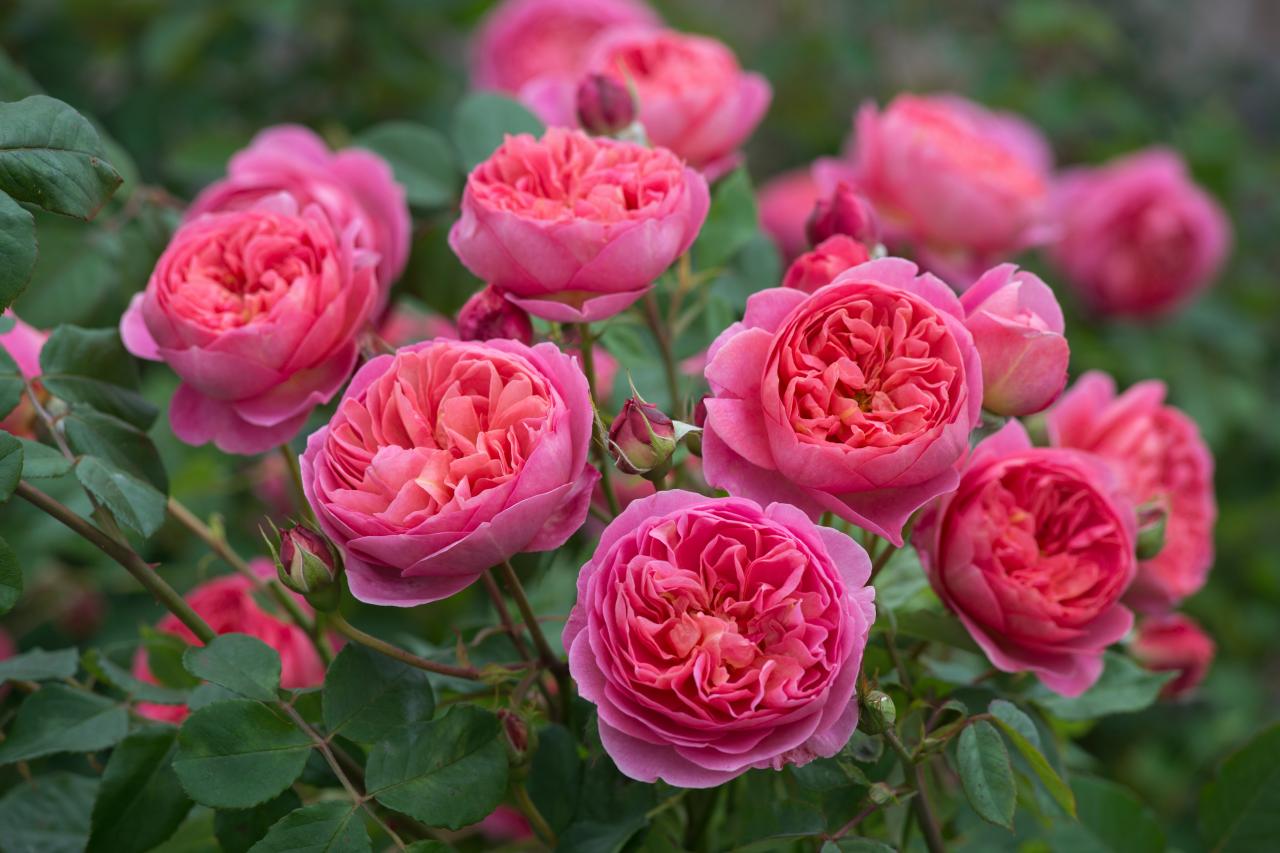 What are the varieties and types of roses
What are the varieties and types of roses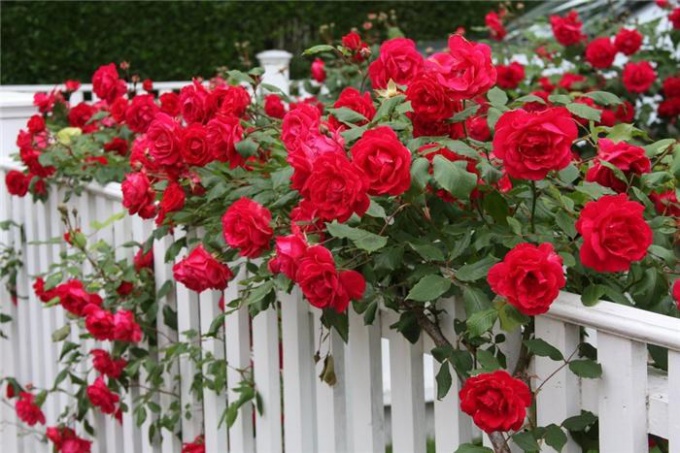 How to process roses with iron sulfate in autumn: proportions, advantages and disadvantages
How to process roses with iron sulfate in autumn: proportions, advantages and disadvantages